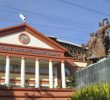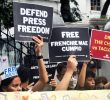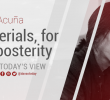By Earl O. Condeza & Tyrone Velez
Davao Today
(Updated 10:50 pm) DAVAO CITY—Thirty years after his death, Benigno ‘Ninoy’ Aquino Jr. is remembered for heroism and human rights advocacy that inspired many Davaoenos and street parliamentarians.
Aquino’s assassination by the Marcos dictatorship led millions to march in his funeral and protests that followed nationwide; the first national welgang bayan was staged in Davao in 1984.
Gabriela Women Partylist representative Luzviminda Ilagan said Ninoy’s death “has a great impact not on my life but also on the lives of millions of Filipinos in that stage in Philippine history. It must be recalled that the people’s movement against the dictator was already growing stronger. With Ninoy’s assassination, the middle class sector was mobilized into action and joined the greater masses who were already in the forefront against tyranny.”
Ilagan, then an Ateneo de Davao professor, became a staunch street activist alongside her late husband human rights lawyer, Laurente ‘Larry’ Ilagan. Rep. Ilagan went on to co-found the Women’s Alliance for True Change- Mindanao (Watch-Mindanao). Other movements came out such as Justice for Aquino, Justice for All; Bagong Alyansang Makabayan; and Nationalist Alliance for Justice, Freedom and Democracy (NAJFD). Lawyers’ group such as Free Legal Assistance Group and Concerned Lawyers’ Union in Mindanao for Nationalism (COLUMN) emerged.
Larry Ilagan was jailed in 1985 along with two other human rights lawyers, current state prosecutor Antonio Arellano and Marcos Risonar.
Malou Tiango, a social worker, professor and writer, was in Manila at that time and joined Ninoy Aquino’s funeral march.
“Talagang nakapagliyab, nakapainit gayud katong iyang kamatayon kay (His death really sparked, enraged) because the bloody image (of Ninoy) was really moving. When the Church took the stand at that time during the leadership of Jaime Cardinal Sin, the people were unified,” she recalled.
Tiangco marched with along the millions who trooped to EDSA on February 1986 in the historic People Power that followed after massive election fraud robbed Aquino’s widow Corazon of victory.
“I was ready to die, so to speak,” Tiangco recounted.
After EDSA, Ilagan, Arellano, Risonar and other political prisoners were released.
But 30 years later, after five presidents, the problems that beset the Filipinos since Marcos such as human rights violations remained. Corruption has rocked the administrations, from Ramos’ PEA-Amari scam, Estrada’s jueteng collection, Arroyo’s kickbacks in government contracts and election fraud to current Pres. Benigno Aquino, III’s soft stance on graft-laden pork barrel.
“Akala ko noon pagkatapos nung kamatayan ni Ninoy, magkakaroon ng makabuluhan na pagbabago. Tumapang tayo. (I thought then after Ninoy’s death, we could have substantial change. We became brave). But in reality, when we speak of democracy as empowerment of the people, bumalik man, nag-iba lang ang mukha, anyo ng karahasan, panlulupig sa mga tao (things came back, the only change were the faces, the forms of abuses and the oppression of the people),” Tiangco said.
Dodong Solis, a leading radio commentator in Davao who started his broadcast days since Martial Law said he is “disgusted, kay nagtoo ko nga dunay mausab after Marcos …dunay mausab human sa pag-alsa sa katawhan tungod sa kamatayon ni Ninoy. Pero wala man gihapon, mas nisamot pa hinoon nga nag-antos ang kinabuhi ug mas grabe pa ang kalisod hangtod karon. (I thought things would change after Marcos, after people rose up because of Ninoy’s death. But nothing happened, people experienced more hardship, and poverty is worse now),” he said.
Rep. Ilagan said Pres. Aquino “has been using this part of history as the convenient justification for his presidency, which, tragically is trekking the old corrupt ways” citing the President’s refusal to scrap the Priority Development Assistance Fund (PDAF) despite the scandals coming out on its misuse.
Tiangco said the country is not under Martial Law “pero pag mag punta ka sa bukid, military man pa rin ang nag-rurule. (When you go to the countryside, it’s the military who rules). The fact that we have evacuees,” she pointed out.
She said the military’s Oplan Bayanihan puts up a front of community development but covers up the real agenda of exploiting natural resources and neutralizing communities
“Ninoy noon, Noynoy ngayon. Naging malaking contradiction ang esensya ni Noynoy na supposedly ang tatay niya parang naging simbolo ng pagpapalaya sa mga military, pero anong ginagawa ni Noynoy? (Ninoy then, Noynoy now. There’s a big contradiction because supposedly his father became a symbol to free us from the military, but what is Noynoy doing now?)” Tiangco asked.
Mae Fe Templa, a social work professor who joined the student movement during Martial Law that revived closed student councils and publications, said “We only installed a new ruling elite disguised as pro-people to sanitize and glamorized rotten system. The democratic space is not commensurate to the nature and depth of people’s struggle for a real democratic, just and free Philippines waged during Marcos dictatorial rule.”
Macario Tiu, award-winning writer, historian and Martial Law detainee, said Ninoy’s death “is a reminder for the need to continue the struggle for human rights and development.”
Dr. Jean Lindo, who was a medical student at the time of Martial Law, said “heroism is not something that becomes irrelevant over time.” saying her death triggered “a stronger and bolder expression of activism” on her, as she continues her environment activism.
UCCP Bishop Modesto Villasanta said Ninoy’s death anniversary may not spark outrage as before, “apan nagatug-an kini nga walay igong gahum ang pagpatay sa pagpukan sa pakigbisog sa katawhan (but it shows that killing the activist will not defeat the people’s struggle).” (with interviews by Earl O. Condeza & Tyrone A. Velez/ davaotoday.com)
edsa, Martial Law, ninoy aquino, ninoy commemoration, ninoy day









